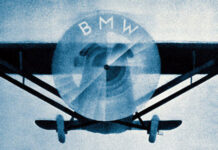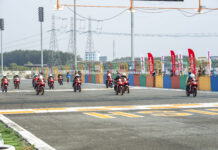“Rare” Ford Mustang V8 2.3L is an iconic representation of American muscle cars – a renowned collection of automobiles known for their powerful and agile performance, embodying the “face of strength” in the realm of stars and stripes.
Despite measuring 4,784 x 1,916 x 1,381 mm (length x width x height) and having a wheelbase of 2,720 mm – comparable to that of a standard C-class sedan, the interior space of the Ford Mustang is relatively modest with only 4 seats, and the rear seats are not conducive for comfortable seating, even for children.
Such is an archetype of the “functionality-oriented design” philosophy adopted by these vehicles. Rather than emphasizing passenger comfort, the Ford Mustang – much like countless other typical American muscle cars – emphasizes superior performance.
This assertion is backed up by the engine bay of the Ford Mustang, which is disproportionately long along the body, pushing the A-pillar deep into the rear. The majority of the space is reserved for the V8 engine – the heart and soul behind the immense power surging within this iconic steed.
This also showcases the shared characteristic between the Ford Mustang and the resolute, rugged, and masculine American spirit: while they may not dress in formal attire or wear impeccably styled hair like office workers, they consistently exude an aura of strength, muscularity, and rugged beauty.
In terms of design, the Ford Mustang still adheres to the aesthetics of the golden age of coupes, boasting a long hood and a sloping roofline endowed with a resolute fastback style. Adorning its body are sleek yet muscular lines, evoking power and vitality.
The robustly designed hood is adorned with two air vents to supplement the V8 heart resting within. Most of the grille area is allocated to the round hexagonal grille, imparting a sense of agility and flexibility rather than rigidity.
The shiny metallic galloping horse emblem is slightly off-centered to the right at the front of the car, deviating from the customary central position – symbolizing the pride associated with the untamed nature of this iconic line of cars and prioritizing the driver’s well-being.
Flanking the vehicle’s sides are large, round projector headlights constituting part of the lighting system. Adjacent to these headlights are three bold LED lines which act as auxiliary lighting, accentuating the distinctiveness and recognizability of the Mustang.
The GT version of the Ford Mustang is equipped with a dual exhaust system featuring two exhaust pipes on each side. Coupled with the air-dammed front bumper, the Mustang stands poised to hit the racetrack and “burn the streets” whenever the driver feels inclined to unleash its speed-conquering potential.
That being said, the rearview mirror represents a significant drawback. The mirror surface is minuscule, and when combined with the broad A-pillar and sloping roofline, it significantly hampers the driver’s visibility. Perhaps this car was designed with a sole purpose: to fulfill the ultimate mission of crossing the finish line swiftly in “Quarter-mile” races – short-distance races covering about ¼ mile, equivalent to over 400m and immensely popular in America, rather than serving as a practical daily driver.
The rear of the Ford Mustang is also highly captivating. The two rear wheel arches boast an immensely muscular design reminiscent of the well-developed thigh muscles on agile stallions galloping through fields.
The rear trunk lid is integrated with a small air spoiler, further accentuating the car’s sporty aesthetics. The aerodynamic details at the car’s front and rear are painted in a cool black hue.
Beneath it all, the Ford Mustang is equipped with a dual exhaust system comprising two exhaust pipes on each side – a characteristic of the GT version. Combined with the frontal positioning of the air dam, the Ford Mustang readily enters the racetrack, ready to operate at high speeds whenever the driver yearns to conquer velocity.
As for the Ford Mustang‘s gearbox, it adheres to a classic design: a round knob capped with a safety lever positioned at its apex. Merely placing one’s hand atop it permits swift gear shifting. Naturally, the gear lever located behind the steering wheel represents an indispensable feature of this sporty model.
Popping the hood and marveling at the Ford Mustang‘s engine bay, one encounters the V8 Ecoboost (turbocharged) engine with a displacement of 2.3L, capable of generating 310 horsepower, which is then transmitted to the rear wheels. In the case of the highest-performance Shelby GT350R version, the vehicle can unleash an output of up to 760 horsepower thanks to its 5.2L V8 VCT engine.
Upon unlatching the door and entering the car’s interior, passengers are sure to be impressed by the Mustang logo embossed onto the doorstep grate. Once again, the designers remind us: never forget that you are stepping onto a wild American horse!
When firmly seated and the door shuts tightly, passengers are once more compelled to immerse themselves in the “American car spirit,” as signified by the rather “memorable” sound emitted by the firmly sealed door – despite the car’s employment of frameless windows.
Drawing parallels with the vehicle’s external design, the interior of the Ford Mustang harmoniously blends classic and contemporary elements, muscularity, and sportiness that cannot be replicated elsewhere. Chrome-plated, large, and thick three-spoke steering wheel bearing the galloping horse emblem at its center only adds to this effect.
All the function buttons of the upscale safety assist package, including features such as lane-keeping assist, intelligent cruise control, and maintaining a safe distance from the preceding vehicle, can be found atop the steering wheel. This comprehensive suite ensures that the car fulfills the US 5-star safety standard.
The steering wheel features a sizable digital display screen measuring up to 12 inches, replete with a modern interface capable of being customized to suit individual driving modes. The interface of this screen prioritizes the graphic representation of engine speed, redlining between 6,500 and 8,000 rpm.
Serving as a high-performance model boasting an ardent sporty spirit, the Ford Mustang is equipped with both oil pressure and turbocharger pressure indicators – professional features typically reserved for race cars.
Beneath the aforementioned screen lies a cluster of entertainment system buttons responsible for adjusting the air conditioning system, featuring a combination of a circular rotary knob and square buttons. This amalgamation generates a classic, robust, and distinctly masculine ambiance within the car.
Of particular note, the buttons controlling the various operating modes are fashioned as classic switches at the very bottom, evoking a decidedly sporty atmosphere. Each distinctive driving mode permits numerous operational settings: throttle sensitivity, heavy or light steering response, firm or soft suspension system, and open or closed exhaust pipes.





















































![[Quick Review] BMW XM arriving in Vietnam: The Ultimate Leader](https://vnauto.net/wp-content/uploads/2023/10/xehay-bmwxm-23062023-13-150x150.jpg)
![[Quick Review] Ford Mustang: The Wild Horse with a Cowboy Spirit](https://vnauto.net/wp-content/uploads/2023/10/xehay-fordmustang-01092022-2-150x150.jpg)













